Category包丁の種類
Japanes style knife
- Western style knife
- Home use
- Tuna knife, market, etc.

Usuba knife
It is a Japanese style knife that specializes in cutting vegetables.The blade is single-ground and the cutting edge is sharp for delicate cutting work such as to peel, chop and cut without crushing the vegetable fiber. (We call the Usuba with a double-ground blade Nakiri.)
It also characterizes some differences in shape between the regions. The Azumagata, developed in the Kanto region (Its tip is square profile. Also called Kakugata.), or
the Kamagata, developed in the Kansai region. (The front of the spine curves gently down toward the tip.)The blade length is measured between the Machi (not the Ago) and the tip.
Details

Mukimono knife
It is said to be one of the knives which originated in the Kanto region.
It features a blade that is single-ground, the spine is much thinner than Usuba’s and the tip is slanted.
The knife is used for more intricate peeling, detailed cutting, and decorative carving vegetables.(Mukimono knives are not suitable for chopping, because the spine is thin so it is not good to touch the knife’s edge with the board frequently.)
The blade length is measured between the Machi (not the Ago) and the tip.
Details

Mentori knife
It is one of the Kansai style Mukimono knives that looks like a smaller Kamagata Usuba knife.
Our Mentori knife is made only by Namigasumi method The blade length is measured between the Machi (not the Ago) and the tip.
Details

Yanagiba knife
It has been popular originally in the Kansai region for sashimi slicing. It is suitable for extremely, fairly thin and paper thin slices of firm textured white fish. It is also widely used for cleaning slender fish, filleting, skinning and plating, and cutting into food and decorative carving by using the tip of the knife. The blade length is measured between the Machi (not the Ago) and the tip.
Details

Takohiki knife
Takohiki is the Kanto region style Sashimi knife.
It is suitable for filleting tuna and Hirazukuri slicing of a softer fish. It can be useful to cut things that are soft, large and long such as Kanten (agar).
The blade length is measured between the Machi (not the Ago) and the tip.
Details

Sakimaru Takohiki knife
Sakimaru Takohiki is a Takohiki with an arc-shaped tip and slightly wider. Takohiki is the Kanto region style Sashimi knife. It is suitable for filleting tuna and Hirazukuri slicing of a softer fish. It can be useful to cut things that are soft, large and long such as Kanten (agar). The blade length is measured between the Machi (not the Ago) and the tip.
Details
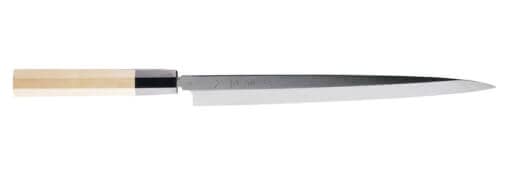
Fuguhiki knife
It is a thin Sashimi knife that is specialized in Usuzukuri slicing. It is used for filleting and slicing a firm white fish like Fugu (puffer fish) extremely thin.
Fugu (puffer fish) is called “Teppou” in the Kansai region. Fuguhiki is also called “Tessa knife” there because of slicing “Teppou” fillet.
The blade length is measured between the Machi (not the Ago) and the tip.
Details

Deba knife (Hon-uchi Deba)
It is a standard type of Japanese traditional knife that is used for fish and meat preparation.
Deba is mainly used for cleaning and filleting fish, cutting through bones and dressing poultry. It is constructed with a thick spine with a single-ground edge.
From the heel to the less middle part of the blade is roughly used for chopping and cutting through hard bones. The rest of the part is used for cleaning and filleting.
The blade length is measured between the Ago (no Machi with Deba) and the tip.
Details
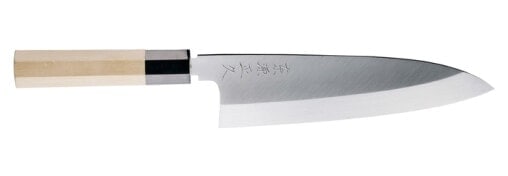
Ai-Deba knife
It is one of the Deba knives that specializes in cleaning and filleting fish more than other Deba.
Although it is not suitable for cutting hard bones, it is good for filleting tender and soft fish beautifully due to the thinner spine to cut through food easily.
It is also often used for skinning Fugu as well as Yanagi Deba because of the easy handling.
The blade length is measured between the Machi (not the Ago) and the tip.
Details

Yanagi Deba knife
It is one of Deba knives that is much thinner and narrower than Ai Deba and often used for skinning Fugu.
Although it is not suitable for cutting bones due to its structure, it is widely used for cleaning and filleting fish quickly and easily.
Details

Mioroshi Deba
It is one of Deba knives that is used for filleting (Mioroshi) as its name suggests.
It features the blade is wider and thinner than Hon Deba and has thin tip.
Although it is not suitable for roughly chopping and cutting through bones, it handles easily so that it is sometimes used both as Deba and Sashimi knife.
Our Mioroshi Deba is forged only Namigasumi method.
The blade length is measured between the Ago (no Machi with the blade) and the tip.
Details

Kurouchi Deba knife (Kuro Deba)
It is a Kurouchi finish Deba knife and it is practically and widely used at the fish shops and the fish processing factories.
It is inexpensive and needs easy care, so it is highly recommended for home cooks and those going fishing.
The blade length is measured between the Ago (no Machi with the blade) and the tip.
Details

Sakekiri (Sake Deba knife)
It is mainly used to cut through a larger and tender fish such as Sake (Salmon) with skin and bones after cleaning.
It looks like Deba, is made wider and thinner than the Deba.
The Sakekiri with Kurouchi finish is practically and widely used.
The blade length is measured between the Ago (no Machi with the blade) and the tip.
Details
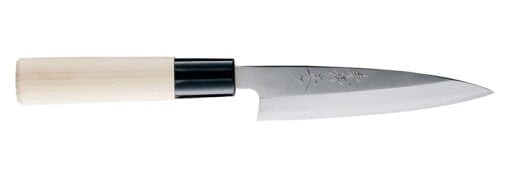
Kaisaki knife
The blade is narrower and thinner than Ko Deba.
It is one of Deba knives that is similar to the much smaller Yanagiba.
Although it is used for cleaning clams as its name “Kai” (clams), it is useful to clean small fish such as Kisu(Japanese whiting)and Megochi (Big-eyed flathead) and prepare fish with Ikijime technique (to drain blood from a live fish to keep it fresh). It is also easy to handle for decorative carving.
The blade length is measured between the Ago (no Machi with the blade) and the tip.
Details
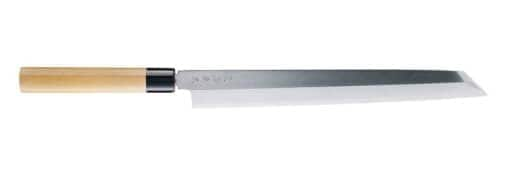
Kiritsuke knife
Kiritsuke knife with single-ground is said to have originated in the Kanto region and began to be used both as Sashimi knife and Usuba knife.
It is useful to cut meat, fish and vegetables. It is called a “Kengata knife” due to the unique shape of a sword. The knife is designed to be useful in cutting food and for decorative carving with the tip.
The blade length is measured between the Machi (not the Ago) and the tip.
Details
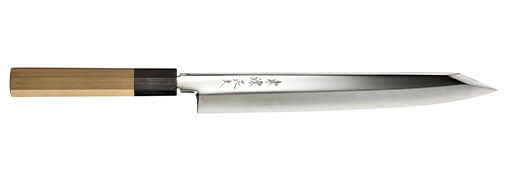
Kiritsuke Yanagiba knife
Kiritsuke Yanagi is a single-ground Sashimi knife and the tip is slated like Kiritsuke knife, which is said to have been mainly used in the Kanto region.
It is used in general as a Yanagiba. The broad and thin cutting edge is useful for Usuzukuri slices and the slanted tip is useful to cut food and for decorative carving.
The blade length is measured between the Machi (not the Ago) and the tip.
Details

Hamokiri knife
It is single-ground and used to perform honekiri on a pike conger fillet which has lots of small bones. Hamo (pike conger) is originally popular in the Kansai region.
It features that the blade is made thick, wide and heavy in order to utilize the weight of the knife to cut small bones.
In recent years the Hamo has been introduced in the Kanto region thanks to expanding logistics.
The knives are widely used not only for Washoku, but also for various cuisines such as Chinese, French and Italian.
The blade length is measured between the Machi (not the Ago) and the tip.
Details

Edosaki knife
It is a traditional eel cleaning knife with a Kanto region style.
It features a slated tip and the blade is sharpened with the Nidanba method (only the tip part is sharpened to make an obtuse angle and to avoid chipping).
It is shaped to best suit the way that eels are filleted from the dorsal side towards the ventral side straight along the bone, taking advantage of the weight and the edge angle.
The Edosaki knives increase in length to be finely divided in size.
Generally many use knives longer than 7 sun (about 21 cm) for eels and shorter ones for conger eels and loaches.
The shorter one is sometimes called a loach knife (Dojosaki).
The blade length is measured between the Ago (no Machi with Edosaki) and the tip.
Details
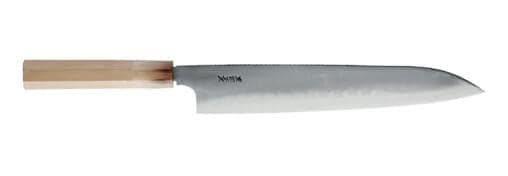
Wagyuto (Japanese style Gyuto)
It is the most basic style of the multi-purpose knife of the western knives with a Japanese style handle.
It is also called the “Chef’s knife” overseas.
The thin blade has a double-ground and carved tip so it is not suitable for cutting hard food material such as bones and frozen foods, but it is convenient for cutting straight and is generally used for meat and vegetables.
Details
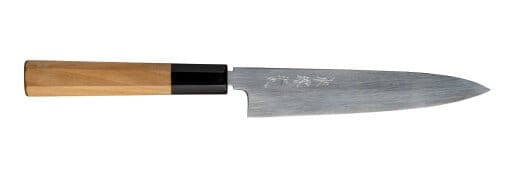
Pairing knife (Japanese style)
It is a general purpose knife whose shape looks like a small Gyuto knife with a Japanese style handle. It is used for small intricate work such as peeling fruits and rounding off corners because of being small and handy,
So it is also called a “Fruits knife”. It is often used for cleaning fish and meat with the advantage of the thin blade and the size for handling as well.
Details
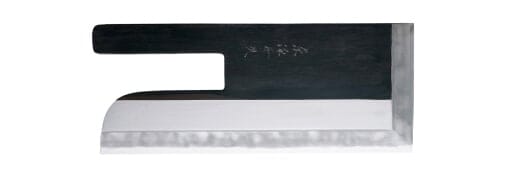
Sobakiri knife
A single ground and used to cut Soba and Udon into noodles .
It features that the blade is large and wide, and a straight cutting edge in order to utilize the weight of the blade to move vertically on the dough when cutting with one stroke. The blade has an unique shape that extends to under the handle and the edge length is long enough to weigh evenly from the heel to the tip.
Details